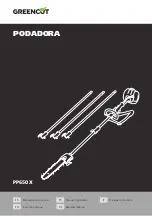
38 SawStop 10” Industrial Cabinet Saw
Using Your Saw
10. Rip Cutting:
Rip cutting or cutting with the grain of the workpiece must be performed with a rip fence to support and guide
the workpiece. The miter gauge should not be used when making rip cuts. The blade guard should be used
for all through cuts.
To begin, make sure the motor
is off and the blade is completely
stopped. Tilt the blade to the
desired tilt angle and adjust the
blade elevation to about 1/8 inch
above the workpiece. Position
the rip fence for the desired
rip width and lock the fence
in place. Refer to the owner’s
manual that accompanied your
rip fence for instructions on
using your fence.
WARNING!
To reduce the chance of a serious injury, always use
a push stick when making rip cuts narrower than 6 inches.
WARNING!
A rip fence must always be used when making rip cuts. Never
perform a ripping operation freehand or a serious injury may result.
Position the workpiece flat on the table and flush against the side of the rip fence. Turn on the motor. Use
both hands to push the workpiece smoothly toward the blade, as shown in Figs. 35 and 36. When there
is approximately 12 inches remaining to be cut, remove the hand farthest from the fence away from the
workpiece. If the rip cut is 6 inches or wider, continue moving the workpiece toward the blade with one hand on
the workpiece and against the rip fence. For rip cuts narrower than 6 inches, always use a push stick to push
the workpiece past the blade. (See page 75 for instructions on making a push stick.)
Fig. 35
Cabinet Saw Manual 1st Reprint.i38 38
3/9/2010 8:32:53 AM
















































